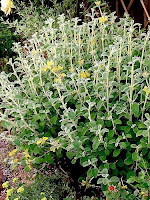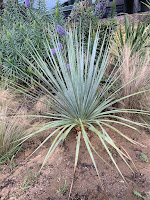Latin name: Euphorbia lambii ("yew-FOR-bee-ah LAM-bee-eye")
Common name: Tree Euphorbia
Originally from: The island of Gomera in the Canary Islands
Blooms: Covered in chartreuse bracts that look like flowers in early spring
Light: Full sun to shade.
Water: Winter rain is enough.
Height x width: 6-10' x 6-10'
Zones: 9b to 12
Where to find in P. Garden: We have several at PG, and lots and lots of seedlings. None at PRG, despite trying!
The genus Euphorbia is a wacky one. Plants in the genus can be shrubs, ground covers, cacti or even trees like this one - a succulent, weird looking mini tree. So easy to grow in the Bay Area - in fact, it seeds around so there will be plenty to share. You wonder why there aren't more to be seen!
With a beautiful form, all the smooth branches rise up symmetrically and are covered in pom-poms of blue-green leaves, which develop even more pom-poms of chartreuse green flower bracts in early spring. Then, if you sit by an e. lambii on a hot day in summer you can hear it pinging it's seeds around as the pods split open.During the heat of summer and fall it will drop a few leaves and the pom-poms get smaller (not a bad look!) but as soon as we get winter rain this little tree always burst into lusciousness again.
It's not a long-lived plant, with 10-15 years being average, but it needs no additional water and is very adaptable in our area. Hard frost will kill it - it is hardy only down to about 25 to 30 degrees - but it's easy to relocate a baby to the greenhouse or inside for safe keeping if a frost threatens. Like all Euphorbias, do avoid the white sap which can be very irritating to eyes and skin.
Rare in its homeland, Euphorbia lambii comes from the island of Gomera in the Canary Islands where it grows on the edge of forests in the northwest and central areas of the island from 2,000 to 2,600 feet up.According to San Marcos Growers:
The name for the genus is derived from Euphorbus, the Greek physician of King Juba II of Numidia and later of Mauritania. In 12 B.C. King Juba named a cactus-like plant he found in the Atlas Mountains after his physician and later Carl Linnaeus assigned the name Euphorbia to the entire genus. The specific epithet honoring British nurseryman Edgar Lamb (1905-1980) was given to this plant in 1960 by the Swedish born Canary Island botanist Eric Sventenius. More recent phylogenetic work has determined that this name should be synonymous with a smaller growing plant also found on the island of Gomera, Euphorbia bourgaeana, and the name Euphorbia lambiorum is also sometimes used.














